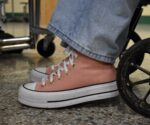Across social media and the internet as a whole, Artificial Intelligence (AI) art is creating a buzz. Websites all across the internet are using algorithms to create unique and creative art pieces. Many people have mixed opinions, including some of the Northwood arts teachers.
“I have an AI app on my phone that I like to use, and I used it last semester for my students,” Visual Arts teacher Leslie Burwell said.
She explained how she thinks AI art is a brand-new art form. In her classroom, she uses it as a medium where students can generate further information on their own work by plugging it into an AI art generator. The students can experiment with different styles ranging from colored pencils to sculpture, seeing their art in more mediums.
“Anything that human beings create is a learning tool,” Burwell said.
Northwood’s Photography Teacher, Jessica Cecchini, discussed using AI art in this year’s yearbook. To do this, the yearbook staff asked a group of students and teachers to answer questions in as much detail as possible. Then, a student plugged all the answers into an AI art generator, picked the one students liked best and submitted it for the yearbook. Cecchini is waiting to hear back from the publishing company, Jostens, to see if they can be printed.
Northwood band teacher Hagen Zoellers has yet to explore AI music, a form of AI art, in his classroom. While unfamiliar with AI musicians, he did have input on the classification of AI music as genuine music.
“I guess we have to start with what we define as music itself. [My background] is in music theory, so this is really interesting to me,” Zoellers said. “Most people, at a philosophical level, will tell you that music is organized sound, and some people would go even further to say that it is intentionally organized sound. [That in] itself opens up controversy,”
Zoellers continued to discuss the intent of the music, citing Music of Change by John Cage. In this intermediate piece, the I Ching, an ancient Chinese divination text, is applied to the music, including the piece’s sounds, tempo, and dynamics. The work was ground-breaking at the time but often described as confusing and challenging to learn. This was the first piece that uses chance in the music by using I Ching in that unique way. Zoellers described this as part of a gray area of music.
“So if we call music organized sound, and we say that it has to be intentionally organized sound, there is no definition that I’m aware of that specifies that music is only created by humans,” Zoellers said.
The advancement of machine learning to create drawings and music has become popular, but it comes with controversy. AI art has caught the attention of artists who have mixed opinions on the technology. The biggest controversy is the way the machines are trained. Many programs have been called out for stealing artists’ work to train the algorithms.
“I think it’s important. I hate the idea of stealing,” Cecchini said. “However, I think that AI art is this brand new place and that it’s too early for me to give [a full idea] because I feel as though in five years or seven years it’s going to have a place…that’s the way it works in the world of art.”
Cecchini described how new art forms have historically been met with skepticism. She initially refused to use a digital camera when the technology first appeared. However, companies don’t produce old film cameras anymore. She also talked about how photography itself was not considered an art form for many years.
Burwell’s opinion on the advancement of AI art is that it is here and artists should be aware of what comes with it.
“I think that artists need to be aware that it’s there, that they can use it as a tool, and show people how they’re using it…if AI is part of their process, then that would show an interesting development in ‘Oh wow! I can use it as a tool,’” Burwell said.
She explained that if the websites are using pieces to train the algorithm, then they need to cite the works used and give credit to the original artists.
While the differing opinions of artists continue to clash, many are looking to the future. Some are worried about the overall impact of their various artistic fields. Is this temporary? Will this take over man-made art? Will this take jobs? All three teachers had varying answers to these questions.
“I don’t think it’s a fad, but I’m not concerned about it…if we continue to care in [musical] communities about valuing live performance, then no, it will never actually take the place of [man-made music],” Zoellers said. “Now at the professional musician level, at the studio recording level, that’s where things start to go into a gray area. But from my perspective, I think that because of the nature of what we do here is train musicians from sixth grade up through high school, there’s no way to replace that with AI.”
Burwell had a similar opinion, claiming AI art would never overtake human-made art.
“If you look at art history, history repeats itself,” Burwell said, discussing the beginnings of the arts and crafts movement. “I think what is going to happen with this conversation is we’ll get a division of people, but that makes more art, and AI can’t take that away.”
Cecchini had similar thoughts on the division of people, stating some photographers will pick it up and others will not. When discussing AI art with photographic quality, she brought up the possibility of flaws in the art becoming a staple of AI art, making it a purposeful choice.

